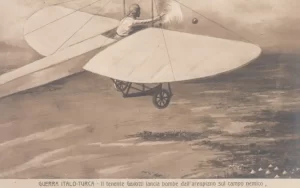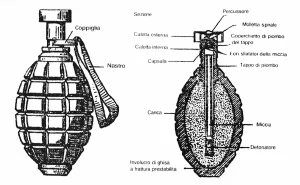
 In what must be considered very unconventional, at least these days, Lieutenant Giulio Gavotti of the Italian army effectively dropped the first aerial bombs on November 1, 1911. He took four grenades (“Cipelli”) in a leather pouch, each of a size of grapefruit and weighing about four pounds. The bombing took place during a flight over Libya, when Gavotti threw three grenades from his aircraft onto a Turkish encampment. These days we wouldn’t have even considered that to be a bombing run, but…well, what else could it be called. Planes were very new, and bombing runs unheard of. It was just eight years after the Wright brothers achieved the world’s first flight in America, and the Kingdom of Italy dispatched several aircraft to Libya, aiming to seize territory in their conflict with the disintegrating Ottoman Empire. Lieutenant Giulio Gavotti boarded one of the Italian army’s wood-and-canvas “Taube” airplanes, carrying four grenades. It was a bold move, but then I’m quite sure that there were no anti-aircraft guns to worry about, and no fighter planes to run from either.
In what must be considered very unconventional, at least these days, Lieutenant Giulio Gavotti of the Italian army effectively dropped the first aerial bombs on November 1, 1911. He took four grenades (“Cipelli”) in a leather pouch, each of a size of grapefruit and weighing about four pounds. The bombing took place during a flight over Libya, when Gavotti threw three grenades from his aircraft onto a Turkish encampment. These days we wouldn’t have even considered that to be a bombing run, but…well, what else could it be called. Planes were very new, and bombing runs unheard of. It was just eight years after the Wright brothers achieved the world’s first flight in America, and the Kingdom of Italy dispatched several aircraft to Libya, aiming to seize territory in their conflict with the disintegrating Ottoman Empire. Lieutenant Giulio Gavotti boarded one of the Italian army’s wood-and-canvas “Taube” airplanes, carrying four grenades. It was a bold move, but then I’m quite sure that there were no anti-aircraft guns to worry about, and no fighter planes to run from either.
Gavotti headed towards the Turkish oasis encampment of Ain Zara, east of what is now Tripoli, and dropped 
 three of his four grenades. This event marked the first instance of live ordnance being released from an aircraft under enemy fire. The Ottoman Empire expressed indignation, alleging that the bombs had hit a field hospital and resulted in civilian casualties. Subsequent investigations by the governments of Great Britain, France, Germany, Russia, and the United States concluded that the bombing likely resulted in minimal, if any, casualties since the grenades either failed to detonate or landed in uninhabited desert areas. Nevertheless, the Ottoman Empire was looking to garner sympathy for the act, and in reality, it was the beginning of many civilian casualties that could later be attributed to the bombings of war.
three of his four grenades. This event marked the first instance of live ordnance being released from an aircraft under enemy fire. The Ottoman Empire expressed indignation, alleging that the bombs had hit a field hospital and resulted in civilian casualties. Subsequent investigations by the governments of Great Britain, France, Germany, Russia, and the United States concluded that the bombing likely resulted in minimal, if any, casualties since the grenades either failed to detonate or landed in uninhabited desert areas. Nevertheless, the Ottoman Empire was looking to garner sympathy for the act, and in reality, it was the beginning of many civilian casualties that could later be attributed to the bombings of war.
While that first “aerial bombing” brought with it limited collateral damage, it signified the beginning of a new era in aerial warfare, nevertheless. A Berlin newspaper observed that although airplanes and airships were not  practical for offensive purposes, they proved indispensable for reconnaissance, stating, “The Italian Command is always, thanks to aircraft, informed of every displacement of Turkish troops, and knows the exact positions of them.” In subsequent years, German Zeppelin airships during World War I carried out bombings over cities throughout Europe, from Antwerp to Paris to London, heralding a time when aircraft would target not just military personnel but also civilian populations. While the Zeppelin bombings were much more effective, the credit for the first aerial bombing goes to the Italians, and Lieutenant Giulio Gavotti. I wonder how shocked the people on the ground were when those grenades dropped.
practical for offensive purposes, they proved indispensable for reconnaissance, stating, “The Italian Command is always, thanks to aircraft, informed of every displacement of Turkish troops, and knows the exact positions of them.” In subsequent years, German Zeppelin airships during World War I carried out bombings over cities throughout Europe, from Antwerp to Paris to London, heralding a time when aircraft would target not just military personnel but also civilian populations. While the Zeppelin bombings were much more effective, the credit for the first aerial bombing goes to the Italians, and Lieutenant Giulio Gavotti. I wonder how shocked the people on the ground were when those grenades dropped.


One Response to First Aerial Bombing